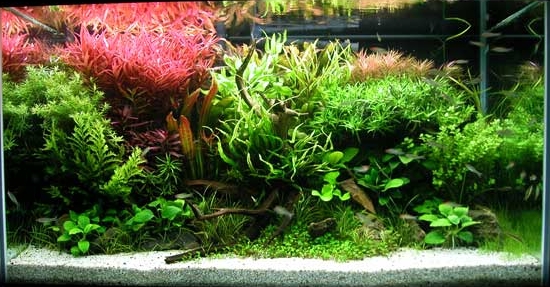the zebra pleco (Hypancistrus zebra)
By Doug White & Derek P.S. Tustin, Images by Klaus Steinhaus
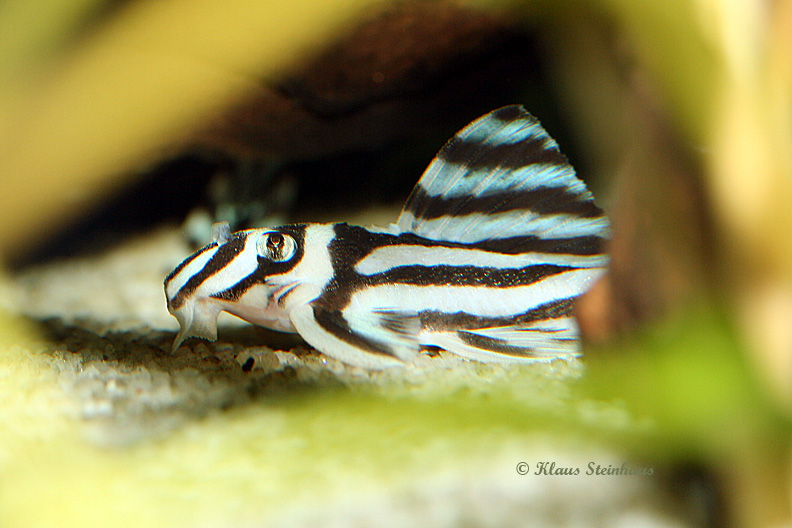
Derek's Back-story
The quote that starts this article is from the esteemed Dr. Seuss. We've all probably read him at one time, either by ourselves when we were younger, or to our children. It's interesting, because I went looking for quotes about the zebra pleco (Hypancistrus zebra) or zebras in general, and there weren't that many out there. But the more I reflected on the quotation, the more I realized that in relation to Doug White and the zebra pleco, it is absolutely true that “There's No End To The Things You Might Know, Depending How Far Beyond Zebra You Go.”Just as the letter “z” is the last letter of the alphabet, and just as “zebra” is indeed one of the last animals listed in the dictionary, so is the zebra pleco the pinnacle of common fish keeping for many aquarists. Beyond that, once the care, keeping, and most importantly breeding of the zebra pleco has been mastered, there is indeed no end to the things you can master, and Doug White is an example of this.
I'm not really sure why I'm writing this article in conjunction with Doug White. The zebra pleco, while one of my personal “golden grails”, has been mastered by him. This is his story, his adventure, his accomplishment. I had the opportunity to sit with Doug over three hours late in February 2011 and listen while he shared his story with me. I'm writing it down, but the words are his.
Doug's Back-story
Some of you will remember the late Jim Brown, who was probably one of the most successful and involved members that the Durham Region Aquarium Society has ever had. While many knew and respected him, he held a special place in my life. To me, he was a big brother, both in the aquarium hobby and in life. I was proud to count him as a close friend.One of the last aquatic endeavors that Jim was working on prior to his passing was an attempt to breed Hypancistrus zebra, the zebra pleco. Unfortunately he never realized his goal prior to his passing, and in his memory I set out to breed this exotic species.
Jim had made the breeding of the zebra pleco one of serious goals. Like his other endeavours in the hobby, he was relentless in his pursuit. When he first started his attempt, which would have been in the late 1990's / early 2000's, there weren't many places where zebra plecos could be acquired. However, That Fish Place in Tonawanda, New York began to acquire stock. Over the course of several trips there, Jim acquired eight fish.
After Jim's untimely passing, DRAS held a memorial auction. As part, the eight zebra plecos he had were up for sale. I won't go into the details, but Kevin and Annette Omura acquired four fish, and I acquired the other four. A couple of years passed and neither Kevin and Annette nor myself were having any success in getting them to breed. Eventually Kevin and Annette agreed to sell me their four fish, and Jim's original school of eight was reunited.
I went looking for more fish, and eventually ended up purchasing a group of eleven on Aquabid. I'm not going to go into the specific amounts that I have paid for the fish, but I think it should be understood that at their peak of rarity, people were selling these fish at $100 per inch. Therefore, a single 3” sub-adult (about three years of age) would sell for $300.00. Prices have dropped in recent years. In the fall of 2010 Lucky's Aquarium in Markham, Ontario were selling 3” fish at $185.00 each. Still pricey, but nowhere near the prices they once were.
Soon after my acquisition of the fish from Kevin and Annette, and soon after my obtaining the eleven fish from Aquabid, they started breeding for me. It took me a long period of trial and error, and the realization that they took a long time to reach sexual maturity, but in the end I accomplished breeding the zebra pleco in honour of my friend, Jim Brown. As the final step, and again in his honour, I'm going to share what I know about them.
Introduction
Sometime in the late 1980's pictures of a new pleco, a striking black and white striped one, began to appear in various publications. This caught the interest of the aquatic community, and soon these beautiful fish, commonly nick-named the zebra pleco, began to appear in various stores. Unfortunately, the price was incredibly expensive. After several years more began to be imported, and the price correspondingly dropped.
However, this wasn't necessarily a good thing. It was soon found that the zebra pleco, along with other Hypancistrus species, were being over-caught, resulting in severe decreases in native populations. In response the Brazilian government banned the export of all Hypancistrus species. This resulted in saving native populations, but also resulted in a shortage in the aquarium hobby along with an increase in price. However, even with the actions of the Brazilian government, the zebra pleco remains at risk. As with progress in all countries, Brazil has undertaken various infrastructure projects, one of which is the proposed construction of the Belo Monte Dam. If completed, and if no corrective actions are taken, the dam could result in the drying out of the entire known distribution range of the Hypancistrus zebra.
(Derek – You know me, I love my research. Wikipedia actually has a rather lengthy article on the Belo Monte Dam, and I think one part is of particular interest to us as aquarists:
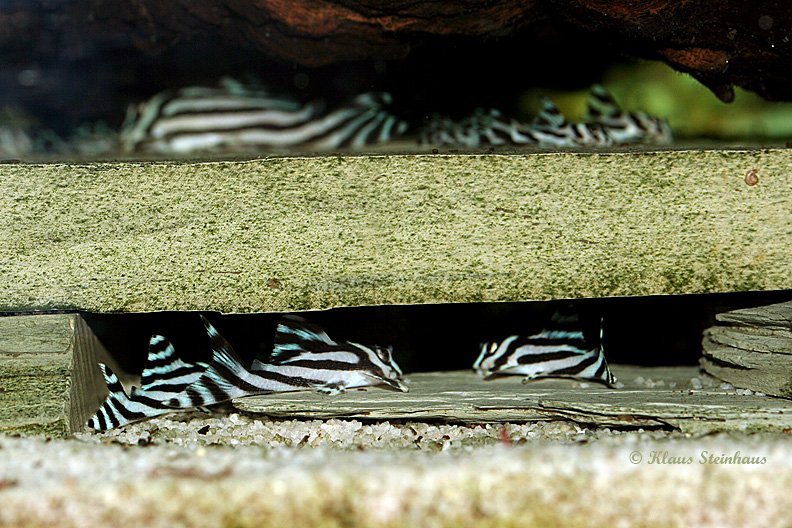
“The fish fauna of the Xingu river is extremely rich with an estimated 600 fish species and a high degree of endemism, with many species found nowhere else in the world. The area either dried out or drowned by the dam spans the entire known world distribution of a number of species, e.g. the Zebra Pleco (Hypancistrus zebra), the Sunshine Pleco (Scobinancistrus aureatus), the Slender Dwarf Pike Cichlid (Teleocichla centisquama), the plant-eating piranha (Ossubtus xinguense) and the Xingu Dart-Poison frog (Allobates crombiei). There has been no assessment of how the dam will impact these unique species.”)
Latin Name
As mentioned Hypancistrus zebra was first discovered in the late 1980's. At the time it was given the provisional L-Number of L046, with a variation being given the name L098. In 1991 Dr. Issac J.H. Isbrucker and Dr. Han Nijssen, both of the Zoological Museum in Amsterdam, determined that the zebra pleco differed strongly from all other known species of loricariids. As such, they determined that it required a new genus, and accordingly erected the genus Hypancistrus, with the Hypancistrus zebra being the first described species.
(Derek – Isn't it amazing how much changes in twenty years? Planetcatfish.com currently lists six described Hypancistrus species, as well as thirty-one Hypancistrus species only identified by L-Number.)
As Latin names go, the “zebra” part makes sense, but the other part, “Hypancistrus”, isn't quite as evident. “Hypo” is derived from ancient Greek and means “less than”, and “ancistrus” is from the Latin for “reduced number of teeth”. With the diet of the zebra pleco (more on this later) the reduced number of teeth makes sense, and saying that they have even fewer teeth than an Ancistrus species also makes sense.
Native Habitat
The Xingu River (properly called the Rio Xingu and pronounced “Shin-goo”) is a tributary of the Amazon River in Brazil. Intensive European exploration of this river began around 1884, and a section of the river located in the Brazilian state of Para about one hour downstream from the town of Altamira, is the only known natural habitat of Hypancistrus zebra.
Rio Xingu is a river of clear water with few nutrients and little sedimentation. As a result the river is exceedingly clear. The riverbed consists mostly of rocks and stones of volcanic origins, many of which are honeycombed with holes and crevices, and a covering of sand between the rocks.
(Derek – Few nutrients = few plants. No wonder I know so little about it…)
General Description
As both their scientific and common names imply, these fish are white based with bold black lateral stripes – like a zebra. The dorsal fin is actually rather high, and the pectoral fins have well defined and developed rays.
While the colouration is actually very striking by itself, it can also be used to determine the health and well being of the fish. If the white sections are bright, and the black stripes are dark, the fish is healthy. Another indicator of health will be a slight blue tinge, especially in the dorsal fin. If the white sections of the fish show any indication of red, then the fish is stressed and steps should be taken immediately to determine the cause.
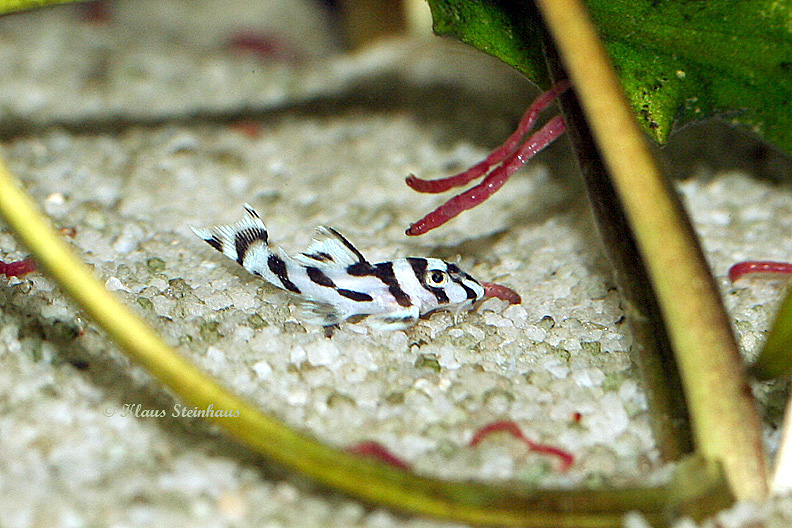
Gender Identification
Males:
- First pectoral ray is thicker
- First pectoral ray will develop spine-like odontodes when in breeding condition
- Broader head when observed from above
Females:
- First pectoral ray is thinner
- Rounder head when observed from above
- Pectoral fins are more of a crescent shape
One of the key factors that was unknown during everyones initial attempts to breed Hypancistrus zebra is that they are not sexually mature until they are about four years old. The fact that there were so many juveniles and so many mature specimens available in the hobby is why so many people were becoming frustrated in their breeding attempts.
Care
People can and do keep zebra plecos as solitary specimens. However, I strongly recommend against this. I have one that I acquired at the Durham Region Aquarium Society Annual Auction two years ago, and it tends to be a more solitary individual than those that were raised in a group setting. A group of three (one male and two females) is acceptable, but ideally you should keep a minimum of two males and four females. Females should always outnumber the males, who can be quite aggressive and territorial.
I have two tanks devoted to Hypancistrus zebra; a 100 gallon tank, and a 110 gallon tank. I personally use Eheim canister filters) with a spray bar attachment sending the water longitudinally along the tank) and Jager 250 watt heaters. Both tanks are glass covered, and I maintain a twelve hour photoperiod. I change 20% of the water every six weeks and only use reverse osmosis (r/o) water. I top up with r/o water as required.
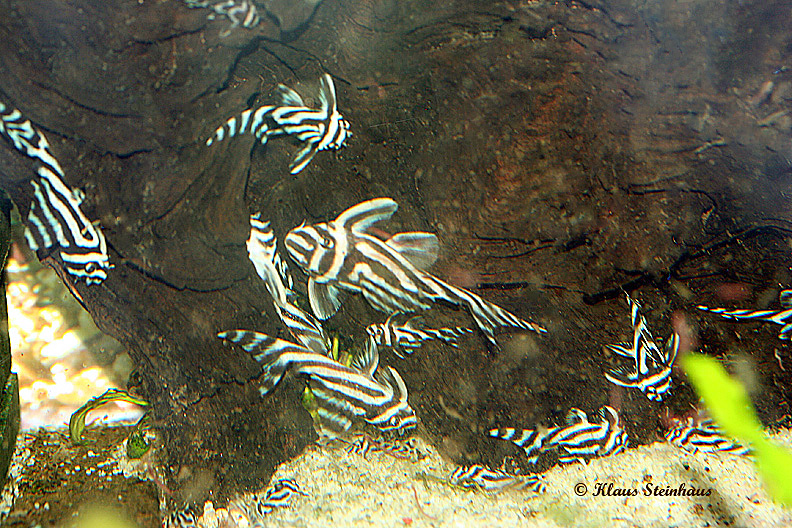
Water Conditions
Maintenance temperature = 28 – 31 °Celsius (82 – 89 °Fahrenheit)
Breeding temperature trigger = 29.8 °Celsius (85.7 °Fahrenheit)
pH = 6.4 – 6.8
Water Movement
In the zebra pleco's native habitat the water is deep and fast flowing, but there is not a heavy current. I believe that a high level of oxygenation is necessary, so you do need surface agitation or an air-stone. As mentioned, I have a spray bar placed at one end of the tank sending the water along the length of the tank, and this seems to satisfy both the water movement they appreciate as well as the dispersal of both food and oxygen along the entire length of the tank.
Tank Decorations
Zebra plecos are very shy and retiring fish. It is not uncommon that when you enter a room they will dart for hiding places. As such, it is extremely important that you provide areas where they can seek shelter. As mentioned, the Rio Xingu riverbed is a mixture of rocks of various sized, many of volcanic origins, with sand spread between them. This is actually very easy to replicate in the aquarium. I use a mixture of slate caves, ceramic caves, and slate “shelves” to provide hiding places. The ceramic caves are used for breeding, but the slate shelves, which essentially are pieces of slate 30 centimetres by 30 centimetres (slightly larger in some instances) placed on top of other slate to provide shallow caves above the substrate. My substrate is aquarium sand.
One thing that should be noted is that the openings to all caves should be perpendicular to the water flow. The zebra pleco does not like water flowing into the cave. Driftwood decorations are optional and do no damage to the zebra pleco. As I will explain when I examine the diet of the zebra pleco, they do not eat much algae and do not eat plants. Therefore it is completely acceptable (but not required) to have plants in the tank.
Suitable Tank Mates
Some people keep zebra plecos in a community tank. However, as they do not compete well for food, especially with faster or aggressive tankmates, I highly recommend that they be kept in a species tank. This seems to significantly reduce stress, and is essential if you want to ensure that there is no predation of offspring.
Feeding
One of the common misconceptions of the zebra pleco (and indeed of some other plecos as well) is that they are algae eaters. While classified as an omnivore, the zebra pleco actually eats more meat than vegetation. If you examine the mouth, you will find that it is actually very small with few teeth. An algae eater requires a larger mouth in order to rasp surfaces of algae, and requires many more teeth to accomplish it.
My feeding regime includes frozen rotifer, frozen daphnia and frozen bloodworms. I do caution that I have experienced small fry choking on bloodworms, but this was a rare occurrence. I should also mention that zebra plecos apparently also relish snails. I have placed both Malaysian trumpet snails (Melanoides tuberculata) and ramshorn snails in my zebra pleco tanks, and in a very short period of time they were completely eradicated.
The zebra pleco tends to eat at night and I feed mine then, but with a regimented feeding schedule, they will come out to eat when the lights are on.
Finally, zebra plecos do not roam about the aquarium searching for food. As mentioned, they are very territorial, and as a result wait for food to come into their general vicinity prior to eating. This is another reason that a water flow that pushes the water past the caves is extremely important.
Breeding Conditions
Everything I've written so far can be applied to any person keeping zebra plecos in general. However, the ultimate goal with these fish is to breed them in order to ensure their survival as a species. There are various sources that will provide information on breeding the zebra pleco, and some of it is contradictory to what I'm about to share. All I can say is that I've been fairly successful in breeding them and have paid very close attention to the circumstances and environmental factors surrounding the numerous breedings.
As mentioned, the caves for the zebra pleco must be perpendicular to the water current in the tank. If it is not, the caves will not be used.
I gave a brief description of slate shelves earlier, and mentioned both slate caves as well as ceramic caves. The slate shelves will not be used for breeding as they are too large and roomy. They are meant solely to provide havens for the general population in a tank.
The other two types of caves are slate caves (basically a slate box silicone together with an opening on one end) and the ceramic caves. The ceramic caves, and which I usually refer to as “bell cones”, are actually ceramic lighthouse aquarium ornaments. When turned on their side, they form an “A” shaped box that narrows towards the enclosed end and is such in height that the male can fully extend his dorsal fin. There are two versions of these, one made entirely out of ceramic and one made with a rubber stopper at the apex. For some reason (I personally suspect an aversion to something in the rubber), my zebra plecos refuse to breed in those with the rubber stopper.
While others have recorded breedings in slate caves, the bell cone is the cave in which all my zebra plecos have bred, and after watching how they actually do so, it is understandable why this is their preferred location. While they will breed in other locations, they will actually search out the most suitable locations, and use that to the exclusion of all else.
If you populate the tank as I recommend, that is with several males and at least two females per male, you will find that the males will establish a hierarchy. One male will become dominant, and he will select a preferred breeding cave. One of the remaining males will become the prime sub-dominant male and will select the next best breeding location, and so on. If enough space is provided, multiple breeding territories will be established.
The first step to initiate breeding is to establish and maintain a temperature of exactly 29.8o Celsius or 85.7o Fahrenheit. Once this temperature is maintained the females will begin to show an interest in commencing breeding.
As mentioned, the males will have established territories including their preferred breeding caves. At this point, the male will usually be found with-in his cave. The female will approach the entrance to the cave and the male will entice the female to enter the cave, where he then traps her. This captivity can last anywhere from one to three days. During that period the female will lay several eggs and the male will fertilize them.
Once the eggs are laid, the male will then evict the female from the breeding cave and begin to care for the eggs himself.
The eggs will usually take about seven to eight days to hatch. It is unusual to see the fry at this stage, but for the first three days, they will still have their yolk sac visible. The males will guard the fry, keeping them in the cave for most of the time. Once the yolk sac is fully absorbed, the male will begin to escort the fry out at night to feed. The fry will still be extremely small at this point, and frozen or live brine shrimp are required. After feeding, the male will herd the fry back into the cave where he continues his care.
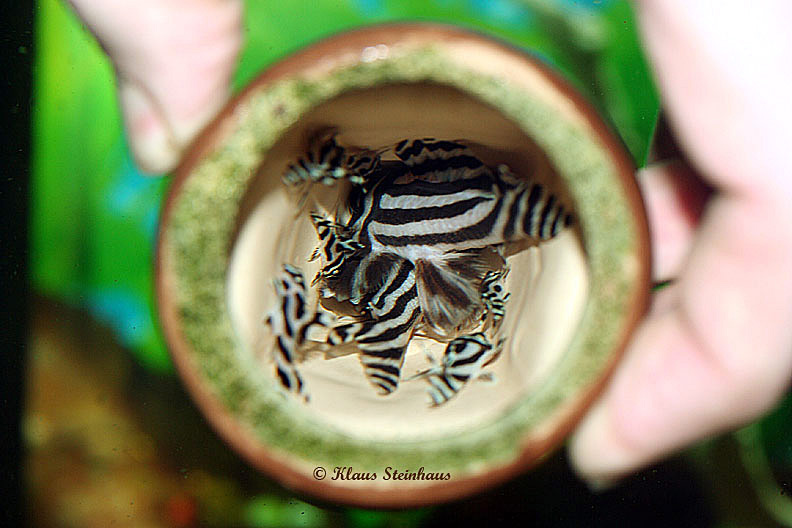
The male will continue his guardianship of the fry for anywhere between six and eight weeks. At this point they will have reached about 2 cm or ¾” in length, and will now be allowed to leave the cave permanently.
I haven't seen mention of this anywhere else, but in my experience I believe that the fry recognize their mother, who then forms nursery for the fry. Multiple generations will gather around the eldest females where they seem to be cared for.
The average number of eggs in a clutch will be around fifteen eggs, but I have also noted that there is a development cycle in the females spawning. I have found that the first clutch of eggs will usually be between six and eight, the next clutch will be slightly larger (around nine to twelve), and the third clutch will be largest with around fifteen eggs. After the third clutch the number of eggs will decrease slightly and remain in that range.
I have also noted that it is imperative that the fry remain in a tank with their parents. I am unsure of why these needs to be, but believe that there may be some chemical released by one or both of the parents that is essential for the fry development.
One time I separated a clutch of eight fry from the parents and into a fully cycled tank. Over a four day period each and every fry died. Prior to death there were no symptoms of disease or distress, but still they all died. I have not experienced this sudden death when the fry remain in the same tank with the parents.
As mentioned, the fry will reach a size of about 2 cm or ¾” when they leave the cave. Around one year of age, they will be around 4 cm or 1½“. They will grow steadily until they reach 10 cm or 4” at four years of age.
Physical deformities are rare, but increasing in the breeding community at large. I believe that the most likely culprit is inbreeding, so it is essential that there be some exchange of stock amongst various breeders to ensure as diverse a genetic pool as possible.
Conclusion
My initial intention when I started working with Hypancistrus zebra was to honour Jim Brown by successfully completing a breeding program that he initiated. While I have succeeded in his honour, I have come to have a personal passion for these fish as well. They are a wonderful fish with gorgeous colouration and interesting group dynamics.
I've bred well over two hundred zebra plecos, my eldest male has fathered at least ten clutches and I have sold a small portion to ensure the genetic diversity of others breeding stock. I'm careful who they go to, and refuse to ship the fish so they must be picked up from me. I've invested a significant amount of money into obtaining and propagating this species, but it is not about a return on investment. It is about their endangered status in the wild and the very real possibility that their native habitat will be destroyed. The fact that they have such small clutches of eggs and the fact that they take so long to mature are obstacles that stand in the way of rapid breeding of the beautiful fish, but now that we have identified them, we can do our part to ensure that they do not become extinct.
I hope you've come to appreciate the zebra pleco even a bit as much as me. If you want to talk about them I encourage you to come talk to me.
Free Template Blogger collection template Hot Deals BERITA_wongANteng SEO theproperty-developer
